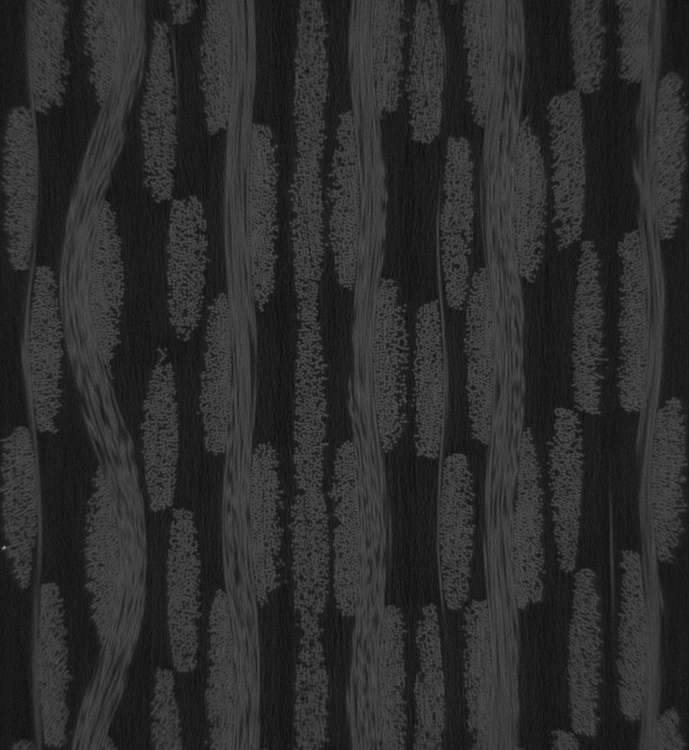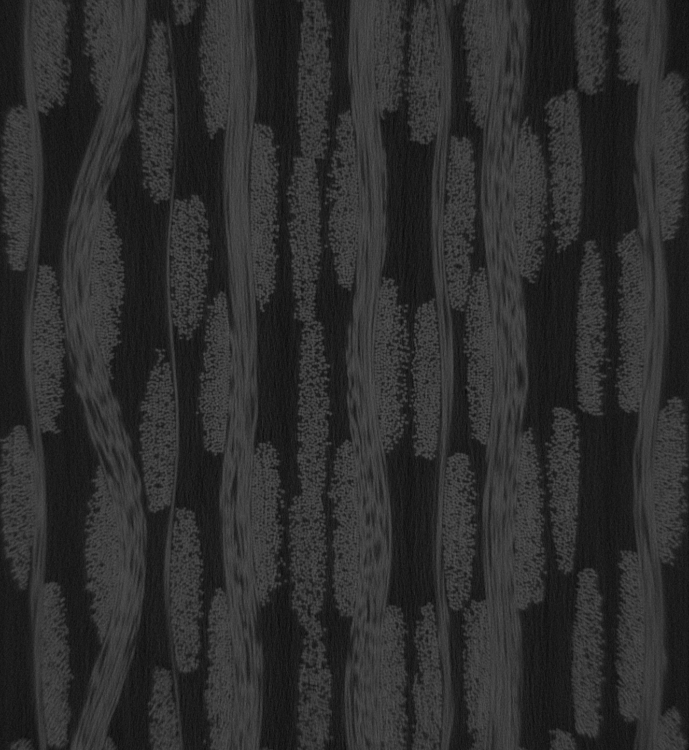Yarns segmentation
|
Hi all!
I have a stack of images of textile composite from X-Ray mCT (about 1500 images, TIFF, 16bit). In this stack there are warp and weft yarns (you can see an exapmple in images below). So i need to separate warp yarns to one stack and weft yarns to the other for the further processing. Have anyone an idea how to do that?  
|
Re: Yarns segmentation
|
Hello Zag,
You can give a try to the Trainable Weka Segmentation <http://fiji.sc/Trainable_Weka_Segmentation>. I converted your images to 8-bit and this is what I got using that plugin: [image: Inline image 1] These are my settings: [image: Inline image 2] I can send you the classifier I got if you want. Cheers! ignacio On Wed, Oct 7, 2015 at 2:06 PM, gvozdin <[hidden email]> wrote: > Hi all! > > I have a stack of images of textile composite from X-Ray mCT (about 1500 > images, TIFF, 16bit). In this stack there are warp and weft yarns (you can > see an exapmple in images below). So i need to separate warp yarns to one > stack and weft yarns to the other for the further processing. > Have anyone an idea how to do that? > <http://imagej.1557.x6.nabble.com/file/n5014571/Subvolume0490.png> > <http://imagej.1557.x6.nabble.com/file/n5014571/Subvolume0509.png> > > > > -- > View this message in context: > http://imagej.1557.x6.nabble.com/Yarns-segmentation-tp5014571.html > Sent from the ImageJ mailing list archive at Nabble.com. > > -- > ImageJ mailing list: http://imagej.nih.gov/ij/list.html > -- Ignacio Arganda-Carreras, Ph.D. Ikerbasque Research Fellow Departamento de Ciencias de la Computacion e Inteligencia Artificial Facultad de Informatica, Universidad del Pais Vasco Paseo de Manuel Lardizabal, 1 20018 Donostia-San Sebastian Guipuzcoa, Spain Phone : +34 943 01 73 25 Website: http://sites.google.com/site/iargandacarreras/ <http://biocomp.cnb.csic.es/~iarganda/index_EN.html> -- ImageJ mailing list: http://imagej.nih.gov/ij/list.html |
|
Hello Zag and Ignacio,
Weka surely works, but can it be applied to 3D images using 3D features? If yes, that would be great for other purposes, too. I often separate weft yarns from warp yarns by calculating local orientation using, e.g., the structure tensor method. Thresholding based on orientation separates the yarns very effectively. - Arttu >-----Original Message----- >From: ImageJ Interest Group [mailto:[hidden email]] On Behalf Of >Ignacio Arganda-Carreras >Sent: 7. lokakuuta 2015 18:24 >To: [hidden email] >Subject: Re: Yarns segmentation > >Hello Zag, > >You can give a try to the Trainable Weka Segmentation ><http://fiji.sc/Trainable_Weka_Segmentation>. > >I converted your images to 8-bit and this is what I got using that plugin: > >[image: Inline image 1] > >These are my settings: > >[image: Inline image 2] > >I can send you the classifier I got if you want. > >Cheers! > >ignacio > > >On Wed, Oct 7, 2015 at 2:06 PM, gvozdin <[hidden email]> wrote: > >> Hi all! >> >> I have a stack of images of textile composite from X-Ray mCT (about >> 1500 images, TIFF, 16bit). In this stack there are warp and weft yarns >> (you can see an exapmple in images below). So i need to separate warp >> yarns to one stack and weft yarns to the other for the further processing. >> Have anyone an idea how to do that? >> <http://imagej.1557.x6.nabble.com/file/n5014571/Subvolume0490.png> >> <http://imagej.1557.x6.nabble.com/file/n5014571/Subvolume0509.png> >> >> >> >> -- >> View this message in context: >> http://imagej.1557.x6.nabble.com/Yarns-segmentation-tp5014571.html >> Sent from the ImageJ mailing list archive at Nabble.com. >> >> -- >> ImageJ mailing list: http://imagej.nih.gov/ij/list.html >> > > > >-- >Ignacio Arganda-Carreras, Ph.D. >Ikerbasque Research Fellow >Departamento de Ciencias de la Computacion e Inteligencia Artificial Facultad >de Informatica, Universidad del Pais Vasco Paseo de Manuel Lardizabal, 1 >20018 Donostia-San Sebastian >Guipuzcoa, Spain > >Phone : +34 943 01 73 25 >Website: http://sites.google.com/site/iargandacarreras/ ><http://biocomp.cnb.csic.es/~iarganda/index_EN.html> > >-- >ImageJ mailing list: http://imagej.nih.gov/ij/list.html -- ImageJ mailing list: http://imagej.nih.gov/ij/list.html |
|
This post was updated on .
In reply to this post by gvozdin
I have one more question about it.
Does anybody kbow how to use Grey-Level Co-occurrence Matrix method for my purposes and how it can be realized using ImageJ. I'm quite new user of software like that so it would be great if somebody explained how to do that step by step. Here's tje link to the study with using the GLCM method for the purpose similar to mine. http://www.sciencedirect.com/science/article/pii/S0263822315005474 Thanks for any helping! |
Re: Yarns segmentation
|
In reply to this post by Miettinen, Arttu
Hello Arttu,
I have implemented some 3D features and you can use them for segmenting 3D images but you need to use library methods. Right now this option is not accessible from the GUI. Have you tried Ilastik <http://ilastik.org/>? Cheers! ignacio On Thu, Oct 8, 2015 at 8:27 AM, Miettinen, Arttu < [hidden email]> wrote: > Hello Zag and Ignacio, > > Weka surely works, but can it be applied to 3D images using 3D features? > If yes, that would be great for other purposes, too. > > I often separate weft yarns from warp yarns by calculating local > orientation using, e.g., the structure tensor method. Thresholding based on > orientation separates the yarns very effectively. > > - Arttu > > > >-----Original Message----- > >From: ImageJ Interest Group [mailto:[hidden email]] On Behalf Of > >Ignacio Arganda-Carreras > >Sent: 7. lokakuuta 2015 18:24 > >To: [hidden email] > >Subject: Re: Yarns segmentation > > > >Hello Zag, > > > >You can give a try to the Trainable Weka Segmentation > ><http://fiji.sc/Trainable_Weka_Segmentation>. > > > >I converted your images to 8-bit and this is what I got using that plugin: > > > >[image: Inline image 1] > > > >These are my settings: > > > >[image: Inline image 2] > > > >I can send you the classifier I got if you want. > > > >Cheers! > > > >ignacio > > > > > >On Wed, Oct 7, 2015 at 2:06 PM, gvozdin <[hidden email]> wrote: > > > >> Hi all! > >> > >> I have a stack of images of textile composite from X-Ray mCT (about > >> 1500 images, TIFF, 16bit). In this stack there are warp and weft yarns > >> (you can see an exapmple in images below). So i need to separate warp > >> yarns to one stack and weft yarns to the other for the further > processing. > >> Have anyone an idea how to do that? > >> <http://imagej.1557.x6.nabble.com/file/n5014571/Subvolume0490.png> > >> <http://imagej.1557.x6.nabble.com/file/n5014571/Subvolume0509.png> > >> > >> > >> > >> -- > >> View this message in context: > >> http://imagej.1557.x6.nabble.com/Yarns-segmentation-tp5014571.html > >> Sent from the ImageJ mailing list archive at Nabble.com. > >> > >> -- > >> ImageJ mailing list: http://imagej.nih.gov/ij/list.html > >> > > > > > > > >-- > >Ignacio Arganda-Carreras, Ph.D. > >Ikerbasque Research Fellow > >Departamento de Ciencias de la Computacion e Inteligencia Artificial > Facultad > >de Informatica, Universidad del Pais Vasco Paseo de Manuel Lardizabal, 1 > >20018 Donostia-San Sebastian > >Guipuzcoa, Spain > > > >Phone : +34 943 01 73 25 > >Website: http://sites.google.com/site/iargandacarreras/ > ><http://biocomp.cnb.csic.es/~iarganda/index_EN.html> > > > >-- > >ImageJ mailing list: http://imagej.nih.gov/ij/list.html > > -- > ImageJ mailing list: http://imagej.nih.gov/ij/list.html > -- Ignacio Arganda-Carreras, Ph.D. Ikerbasque Research Fellow Departamento de Ciencias de la Computacion e Inteligencia Artificial Facultad de Informatica, Universidad del Pais Vasco Paseo de Manuel Lardizabal, 1 20018 Donostia-San Sebastian Guipuzcoa, Spain Phone : +34 943 01 73 25 Website: http://sites.google.com/site/iargandacarreras/ <http://biocomp.cnb.csic.es/~iarganda/index_EN.html> -- ImageJ mailing list: http://imagej.nih.gov/ij/list.html |
«
Return to ImageJ
|
1 view|%1 views
| Free forum by Nabble | Edit this page |

